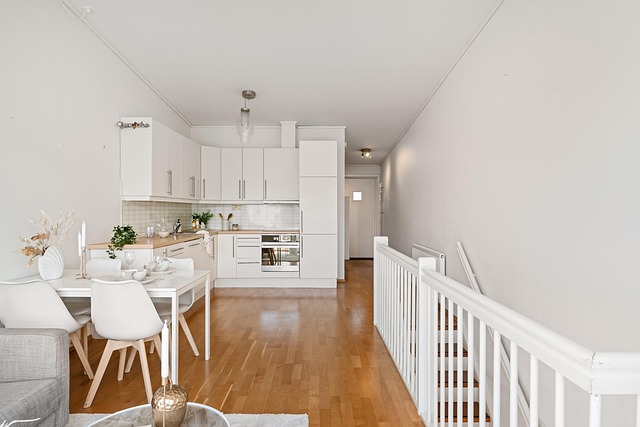Touchless technology has emerged as a game-changer in modern kitchens, driven by demands for convenience, hygiene, and sustainability. Touchless faucets and smart kitchen appliances leverage sensor technology and voice commands to offer hands-free operation, water conservation, and energy efficiency. These innovations appeal to eco-conscious consumers seeking to reduce utility bills and environmental impact while enhancing user experience through remote control and personalized settings. Future kitchens will feature advanced, sustainable, and convenient energy-efficient kitchen appliances that integrate artificial intelligence and smart technology for optimal performance and user satisfaction.
The modern kitchen is undergoing a silent revolution, driven by advanced fixture technology. Among these innovations, touchless faucets are leading the charge in both style and sustainability. This article explores the rise of touchless technology in kitchen fixtures, its energy efficiency and water conservation benefits, and the advanced features integrating smart homes. We also delve into future trends, highlighting how innovations are shaping the future of energy-efficient kitchen appliances.
- The Rise of Touchless Technology in Kitchen Fixtures
- Energy Efficiency and Water Conservation with Touchless Faucets
- Advanced Features and Smart Integration
- Future Trends: Innovations Shaping Kitchen Appliances
The Rise of Touchless Technology in Kitchen Fixtures
In recent years, the integration of touchless technology into kitchen fixtures has revolutionized the way we interact with our everyday tools. This shift is driven by a growing demand for convenience, hygiene, and sustainability—all hallmarks of modern living. Touchless faucets, for instance, offer hands-free operation, eliminating the need for traditional faucet handles and reducing cross-contamination risks. As consumers become increasingly conscious of energy efficiency, these fixtures also contribute to water conservation efforts, which are crucial in the quest for sustainable homes.
The adoption of touchless technology extends beyond faucets; it encompasses a broader range of advanced fixture innovations. Smart kitchen appliances, now more accessible than ever, leverage sensor technology and voice commands to enhance user experience. These energy-efficient kitchen appliances not only save time but also contribute to reduced electricity bills and lower environmental impact, making them attractive options for eco-conscious consumers.
Energy Efficiency and Water Conservation with Touchless Faucets
Touchless faucets are revolutionizing the way we interact with our kitchens, offering more than just convenience. One of their most notable benefits is energy efficiency and water conservation. By eliminating the need for manual operation, these advanced fixtures significantly reduce water wastage, as they are designed to turn off automatically after each use. This feature ensures that water is not left running unnecessarily, a common culprit in traditional faucets.
Moreover, many touchless faucets incorporate smart technology that optimizes water flow based on hand movement, providing just the right amount of water needed. This precision in control translates to considerable savings on energy bills as well. The sensors and advanced mechanisms used in these fixtures are designed to be highly responsive, allowing for efficient water usage while still maintaining a luxurious user experience. With their energy-efficient design, touchless kitchen appliances like faucets contribute to a more sustainable lifestyle and help reduce the environmental impact of daily activities.
Advanced Features and Smart Integration
Advanced features and smart integration are transforming the way we interact with our kitchen fixtures. Touchless faucets, for instance, offer a seamless experience by detecting hands and activating water flow, promoting hygiene and convenience. These innovative solutions often come packed with additional functionalities such as adjustable water temperature and pressure, as well as energy-efficient operation, making them ideal for modern kitchens.
Smart integration takes this a step further by connecting these fixtures to home automation systems. Through voice commands or mobile apps, users can control their touchless faucets remotely, setting preferences and customizing settings according to personal needs. This technology not only enhances user experience but also contributes to energy efficiency by allowing precise control over water usage, making them a popular choice for eco-conscious homeowners looking for high-tech upgrades in their kitchen appliances.
Future Trends: Innovations Shaping Kitchen Appliances
The future of kitchen fixtures is bright and innovative, with a strong focus on sustainability and convenience. As technology advances, we can expect to see more smart, touchless appliances that not only enhance our daily routines but also contribute to an eco-friendly lifestyle. One notable trend is the integration of voice control and artificial intelligence into kitchen gadgets, allowing for hands-free operation and personalized experiences.
Energy-efficient kitchen appliances are becoming the norm, with advancements in sensor technology and water-saving mechanisms. These innovations not only reduce utility costs but also minimize environmental impact. Additionally, designers are exploring new materials and finishes, ensuring durability and aesthetic appeal while keeping up with the latest design trends. The fusion of form and function promises to revolutionize our kitchens, making them more efficient, comfortable, and sustainable spaces.
The integration of touchless technology in kitchen fixtures, including advanced features like smart integration, represents a significant step forward in creating energy-efficient kitchen appliances. These innovations not only promote water conservation but also enhance user experience through convenience and hygiene. As we look towards the future, expect to see even more sophisticated designs that further optimize resource use, ensuring a sustainable and efficient culinary environment.
